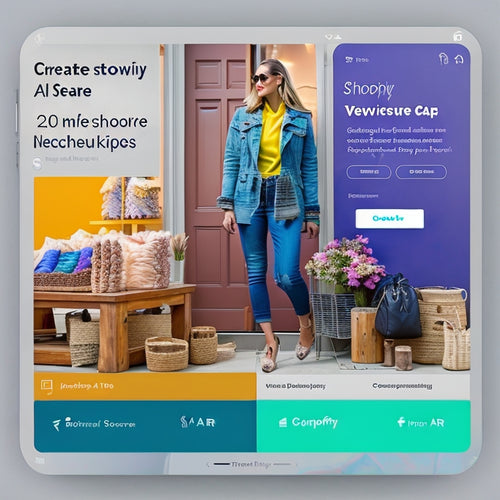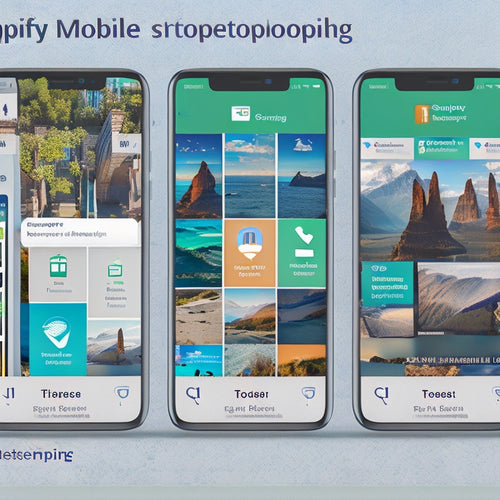
Succeed With Online Courses for Customer Success
Share
You're about to reveal the secret to transforming your customer success strategy with online courses. By mastering personalized experiences, effective communication, and feedback analysis, you'll increase customer retention by up to 25% and boost satisfaction ratings by 15%. To succeed, you'll need to develop a customer loyalty strategy, craft tailored engagement plans, and build emotional connections with your customers. You'll also learn how to handle complaints, monitor account health, and measure customer success metrics. As you dive deeper, you'll discover the tools and techniques to create a customer-centric approach that drives long-term loyalty and growth.
Key Takeaways
• Develop a customer loyalty strategy by understanding needs and preferences to craft personalized experiences exceeding expectations.
• Master effective communication and complaint handling to build trust, diffuse tension, and turn negative experiences into positive ones.
• Analyze customer feedback to uncover valuable insights, identify areas of improvement, and make data-driven decisions that impact NPS.
• Monitor account health by tracking key performance indicators to prioritize proactive engagement and retention strategies for long-term loyalty.
• Create tailored engagement strategies and loyalty programs that offer rewards, personalized learning, and targeted messaging to drive customer satisfaction.
Building Customer Loyalty Strategies
To build a loyal customer base, you need to develop a customer loyalty strategy that focuses on understanding their needs, preferences, and pain points. This means digging deeper to identify what drives customer satisfaction and what hinders it. By doing so, you'll be able to craft personalized experiences that exceed their expectations, fostering a sense of belonging and loyalty.
One effective way to achieve this is by implementing loyalty programs that reward customers for their repeat business. This can be in the form of points, discounts, or exclusive offers. The key is to make sure these programs are tailored to your customers' unique needs and preferences.
For instance, if your customers value convenience, consider offering loyalty rewards that can be redeemed online or in-store. By showing your customers that you care about their experience, you'll be more likely to earn their loyalty and advocacy.
Effective Communication in Ecommerce
As you focus on building customer loyalty, you'll quickly realize that effective communication is the backbone of a successful ecommerce strategy, and it starts with being clear about what your customers can expect from your brand. This means setting transparent expectations around shipping, returns, and customer support. When you communicate clearly, you build trust and set yourself up for long-term success.
But effective communication goes beyond just words. It's also about active listening and paying attention to nonverbal cues. When customers reach out to you, make sure you're fully present and engaged in the conversation. This means putting away distractions and focusing on their concerns.
Pay attention to tone, language, and even emojis – these can give you valuable insights into your customers' emotions and needs.
Mastering Customer Feedback Analysis
You've collected a treasure trove of customer feedback, but now it's time to dig in and uncover the valuable insights hidden within. It's essential to master customer feedback analysis to understand what your customers are saying, and more importantly, what they're not saying.
Effective feedback interpretation is key to identifying areas of improvement and opportunities for growth. By analyzing customer sentiment, you can track patterns and trends, and make data-driven decisions to enhance your customer experience.
To get started, categorize your feedback into themes and prioritize them based on frequency and impact. Then, drill down into each theme to understand the root cause of the issue. Don't be afraid to ask follow-up questions to clarify customer concerns.
Developing Personalized Customer Experiences
When you're developing personalized customer experiences, you're not just trying to meet customer needs - you're aiming to exceed their expectations.
To achieve this, you'll need to craft tailored engagement strategies that speak directly to each customer's unique pain points and goals. By doing so, you'll be able to build a strong emotional connection with your customers, fostering loyalty and driving long-term growth.
Tailored Engagement Strategies
To truly resonate with your customers, develop tailored engagement strategies that acknowledge their unique needs, preferences, and pain points, allowing you to craft personalized experiences that speak directly to them.
By doing so, you can create a sense of belonging and understanding that fosters loyalty and advocacy.
Here are some ways to tailor your engagement strategies:
-
Personalized learning: Use interactive modules that adapt to individual learning styles and needs, ensuring that customers gain the most value from your online courses.
-
Targeted messaging: Craft customer engagement campaigns that speak to specific pain points and interests, increasing the likelihood of conversion and retention.
-
Dynamic content: Use customer data to serve up relevant content that resonates with their current needs and interests.
- Omnichannel support: Provide seamless support across all touchpoints, ensuring that customers receive consistent and personalized experiences regardless of how they interact with your brand.
Emotional Connection Building
By acknowledging and addressing the unique emotional needs and motivations behind customer interactions, you can build strong emotional connections that drive loyalty and advocacy. This is where emotional connection building comes in – an essential aspect of developing personalized customer experiences.
You see, customers don't just want solutions; they want to feel heard, understood, and valued. By investing in empathy training, you can equip your team with the skills to actively listen, acknowledge, and respond to customers' emotional cues. This, in turn, fosters trust building, a foundation for long-term relationships.
When you take the time to understand your customers' emotional needs, you can tailor your interactions to meet them where they are. This might mean offering personalized support, acknowledging their pain points, or simply showing appreciation for their business.
Navigating Customer Complaints Successfully
Dealing with customer complaints can be a challenging task, but it's an essential opportunity for you to showcase your customer success skills and turn a negative experience into a positive one. When a customer complains, they're not just expressing frustration - they're giving you a chance to listen, understand, and resolve their issue.
This is where your customer empathy and active listening skills come into play.
Here are some tips to help you navigate customer complaints successfully:
-
Stay calm and composed: Use de-escalation techniques to diffuse tension and create a safe space for conversation.
-
Listen actively: Pay attention to the customer's concerns, ask clarifying questions, and acknowledge their feelings.
-
Offer solutions: Provide alternatives or compromises that meet the customer's needs, such as handling refunds or suggesting different products.
- Follow up: Check in with the customer after the issue has been resolved to make certain they're satisfied and to gather feedback.
Creating Customer Retention Plans
You've worked hard to resolve customer complaints, and now it's time to focus on keeping those satisfied customers loyal, which is where a well-organized customer retention plan comes in.
This plan is important in securing customer satisfaction and driving retention rates. By prioritizing customer retention, you'll reduce churn, increase revenue, and build a loyal customer base.
To create an effective retention plan, start by identifying your most valuable customers and understanding their needs, preferences, and pain points. Develop personalized engagement strategies that cater to these needs, such as offering exclusive rewards, early access to new features, or dedicated support channels.
Regularly solicit feedback to make sure you're meeting their evolving expectations.
Measuring Customer Success Metrics
When you're measuring customer success metrics, you're likely wondering what numbers to focus on. You'll want to track metrics that give you a clear picture of how your customers are doing, and two key ones to start with are Net Promoter Score (NPS) and the health of your accounts.
Net Promoter Score
Measuring customer success metrics is essential to understanding how well your customer success strategy is performing, and one key metric that can help you do just that's the Net Promoter Score (NPS). NPS is a simple yet powerful way to gauge customer satisfaction and loyalty. By asking one simple question - 'On a scale of 0-10, how likely are you to recommend our product/service to a friend or colleague?' - you can get a clear picture of how your customers feel about your brand.
Here are 4 ways NPS can help you improve customer success:
-
Identify areas for improvement: By tracking NPS over time, you can spot trends and areas where you need to make changes to improve satisfaction.
-
Increase referrals: Happy customers are more likely to refer others, which can lead to increased revenue and growth.
-
Reduce churn: By identifying unhappy customers, you can take proactive steps to address their concerns and reduce the likelihood of them leaving.
- Improve customer loyalty: By prioritizing customer satisfaction, you can build strong, lasting relationships that drive long-term growth and success.
Health of Accounts
As you're gauging customer sentiment through NPS, it's equally important to assess the overall Health of Accounts, which provides a holistic view of each customer's relationship with your brand. This metric allows you to monitor account activity, identify potential issues, and take proactive measures to guarantee customer satisfaction.
By keeping a pulse on account health, you can detect early warning signs of churn and implement retention strategies to prevent it.
Effective account monitoring involves tracking key performance indicators such as product adoption, support ticket volume, and payment history. This data helps you understand each customer's unique needs and preferences, enabling you to tailor your approach to meet their expectations.
A healthy account is more likely to lead to long-term loyalty and advocacy, so prioritize regular check-ins and proactive engagement. By doing so, you'll foster strong relationships, drive revenue growth, and ultimately, boost client health.
Frequently Asked Questions
How Do I Ensure Course Material Is Relevant to My Customers' Needs?
You maintain course material relevance by actively seeking customer feedback, staying on top of industry trends, and analyzing competitors, all while curating content that resonates with your customers' ever-evolving needs and pain points.
Can I Use Online Courses to Onboard New Customers Quickly?
"Imagine being a medieval knight, swiftly arming your new customers with knowledge! You can, by leveraging online courses for accelerated learning, boosting customer engagement, and offering personalized training that fuels customer satisfaction."
Are Online Courses Suitable for B2B Customer Success Strategies?
You're wondering if online courses are suitable for B2B customer success strategies. Absolutely! You can create interactive workshops and virtual simulations that engage clients, build trust, and drive long-term success in your B2B relationships.
How Do I Measure the ROI of Online Customer Success Courses?
You're wondering how to measure the ROI of online customer success courses, and the answer lies in gauging effectiveness by tracking progress, but first, let's set the stage for success by defining what matters most to your business.
Can I Customize Online Courses for Different Customer Segments?
You can tailor online courses to specific customer segments by customizing content to meet their unique needs, ensuring you're effectively targeting audiences and driving results that matter to each group.
Related Posts
-

Marketing Shopify Apps Assist Merchants in Promoting Their Store, Products, and Special Offers
Marketing Shopify apps play a crucial role in assisting merchants in promoting their store, products, and special of...
-

How Do I Optimize My Website for SEO Shopify
This article examines strategies for optimizing websites on the Shopify platform for search engine optimization (SEO...
-

Benefits of Listing Your App in the Shopify App Store
This article explores the benefits of listing an app in the Shopify App Store. It focuses on the advantages in terms...


